
CHAPTER FOUR

CHAPTER FOUR
SANDWICHES, SANDWICHES, SANDWICHES

The Israeli Guy’s Falafel Sandwich
Tuna Niçoise Sandwich with Arugula and Frisée
Pressed Vegetarian Muffaletta on Focaccia
Lobster Roll with Old Bay and Celery
Fish Tacos with Avocado Crème and Spicy Chipotle Salsa
Curried Chicken Sandwich with Cashews and Currants
Fried Chicken Sandwich with Buttermilk-Jicama Slaw
Hot Fried Chicken Sandwich with Biscuits and Coffee-Laced Gravy
When YOU’RE IN MY BUSINESS, the question you always get is “What kind of restaurant is it?” Some places afford a straightforward answer. Anchor & Hope, for example, can be easily described as a fish house. But a restaurant like Town Hall, which takes its culinary cues from a variety of sources, is more difficult. Probably the best description of its menu is regional American. And nothing fits that tag better than a sandwich.
SANDWICHES, maybe more than any other dishes, evoke a certain place, region, or even era. A lobster roll is the essence of New England, a fried chicken sandwich is the South, and a tuna salad sandwich evokes a midcentury, suburban idyll. They can be more specific representations of place, too. In New Orleans, I don’t feel as if I’ve really arrived, am not really there, until I’ve grabbed a roast beef po’boy at Domilise’s (or one from Magazine Street Po Boy, an unheralded gem) or a muffaletta at the Central Grocery. Not only are some sandwiches emblematic of entire cities (cheesesteak anyone? beef on weck?), but sandwiches also reveal the tastes and flavors of a region’s ethnic enclaves. Falafel in pita is available in a city’s Middle Eastern district, Cubanos are everywhere in the Latin neighborhoods of urban Florida, and isn’t the taco just an open-faced sandwich with a fold? In other words, you can learn a lot about a place by checking out what it stuffs between two slices of bread.
THIS CHAPTER will take you to places in the kitchen that perhaps you’ve never gone. Here you’ll find a recipe to grind and case your own sausage, and after you poach tuna in olive oil, you might never buy canned again. Sorry, Charlie.
STEVEN AND I started our careers in a delicatessen. Those years taught us what makes a sandwich great. One thing I learned is that a sandwich is the sum of its parts, so always try to get the best-quality ingredients, especially bread. That shouldn’t surprise you. After all, what makes a sandwich a sandwich but its infrastructure?
The Israeli Guy’s Falafel Sandwich


One of my and Steven’s coworkers at the Celebrity Deli was from Israel. For the life of me, I can’t remember his name. What I do remember is that he made great falafel. I was talking with Steven one day, going over what to put in this chapter, and I said, “Remember that Israeli guy at the deli? I want to put his falafel in the book.” Steven replied, “Why don’t you?” I told him I didn’t have the recipe. But he did. An hour later I received this recipe by email. We dress the falafel with a bright Turkish salad, tahini sauce, and a spicy harissa. That last flourish is an homage to L’As du Fallafel, a favorite spot in the Marais.

 MAKES 6 SANDWICHES
MAKES 6 SANDWICHES 
FALAFEL
1 rounded cup (½ pound) dried chickpeas, picked over, soaked overnight, and drained
1 bunch cilantro, stems removed
1 bunch flat-leaf parsley, stems removed
1 tablespoon ground coriander
1 tablespoon ground cumin
1 yellow onion, coarsely chopped
2 cloves garlic, coarsely chopped
1 large egg
¼ cup chickpea flour
1 tablespoon salt, plus more for seasoning
1 teaspoon baking soda
Canola oil, for deep-frying
TAHINI SAUCE
2 cloves garlic
Salt and freshly ground pepper
3 tablespoons tahini
Juice of 1 lemon
4 tablespoons water
TURKISH SALAD
1 red bell pepper, seeded and diced
1 cucumber, trimmed and diced
½ red onion, diced
24 cherry tomatoes, halved
¼ cup extra-virgin olive oil
Juice of 1 lemon
2 tablespoons chopped fresh cilantro
2 pinches of salt
4 pita breads, halved
TO MAKE THE FALAFEL, place the drained chickpeas in a food processor and process until smooth. Add the cilantro, parsley, coriander, cumin, yellow onion, and garlic and process until the mixture forms a smooth paste. Transfer the paste to a large bowl, add the egg, chickpea flour, salt, and baking soda, and mix well. Let rest for at least an hour or up to a day.
TO PREPARE THE TAHINI SAUCE, place the garlic cloves in a mortar with a pinch of salt and pound with a pestle until a paste forms. Transfer the garlic paste to a small bowl and stir in the tahini, lemon juice, and water. Season with salt and pepper and set aside.
TO MAKE THE SALAD, in a bowl, combine the bell pepper, cucumber, red onion, and tomatoes and toss to mix. Add the oil, lemon juice, cilantro, and salt and stir well to combine.
TO FRY THE FALAFEL, pour the oil to a depth of 3½ inches into a deep fryer or deep, heavy-bottomed pot and heat to 350°F. While the oil is heating, using your hands, form the falafel mixture into 24 walnut-sized pieces then flatten into patties.
Working in batches to avoid crowding, add the falafel to the hot oil and fry for 3 to 4 minutes, or until they are a deep, dark brown. Using a slotted spoon, transfer the falafel to paper towels and season with salt. Keep warm while you fry the remaining falafel.
To serve, place 3 or 4 hot falafel in a halved pita, add a few spoonfuls of the salad, and top with the tahini sauce and the vinaigrette. Serve immediately.
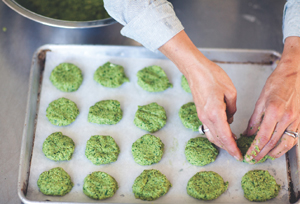
Tuna Niçoisse Sandwich with Arugula and Frisée


You want a tuna sandwich? This is a tuna sandwich. No fooling with canned tuna here. Instead, this calls for fresh tuna marinated in olive oil, garlic, and thyme, and then poached in more olive oil. Your tuna confit is then all done up as a salad in the niçoise manner. And then, if your feeling extra fancy and decadent, go ahead and top that beautiful tuna niçoise with, yes, more tuna, this time seared. Of course, that final flourish is not necessary, but it does take the sandwich to another realm, so I’ve included the directions if you want to give it a try (take one look at the accompanying photograph and you are going to want to do it). And for good measure, the whole thing is topped with a hard-boiled egg. Yes, this is a tuna sandwich.
You can prepare the tuna confit a day ahead, and if you have any of the tuna salad left over, it’s also delicious stuffed into a tomato or bell pepper.

 MAKES 6 SANDWICHES
MAKES 6 SANDWICHES 
TUNA CONFIT
1 pound albacore tuna fillet cut into walnut-sized pieces
2 tarragon sprigs
2 thyme sprigs
1 shallot, sliced
2 cloves garlic, peeled but left whole
About 1½ cups extra-virgin olive oil
¼ cup niçoise olives, pitted and chopped
Grated zest of 1 lemon
1 clove garlic, minced
1 tablespoon extra-virgin olive oil
TUNA SALAD
Tuna confit (above)
¼ cup tapenade (above)
1 tablespoon red wine vinegar
1 tablespoon whole grain mustard
¼ cup extra-virgin olive oil
¼ cup Mayonnaise
Juice of 1½ lemons (about ¼ cup)
2 tablespoons chopped fresh tarragon
2 tablespoons chopped flat-leaf parsley
2 tablespoons chopped chervil
2 tablespoons chopped chives
Salt and freshly ground pepper
SEARED TUNA (OPTIONAL)
¾ pound yellowfin tuna (ahi) loin
Ground coriander
Salt and freshly ground pepper
Canola oil, for cooking
2 cups arugula
2 cups frisée
3 tablespoons lemon oil or 3 tablespoons extra-virgin olive oil mixed with a few healthy squeezes of lemon juice
Salt and freshly ground pepper
2 baguettes, each cut crosswise into thirds, then each third split horizontally
3 large eggs, hard boiled, peeled, and quartered lengthwise
TO PREPARE THE TUNA CONFIT, arrange the tuna pieces in a sauté pan just large enough to hold them in a single layer. Add the tarragon and thyme sprigs, shallot, and garlic. Pour in the olive oil just to cover. Place the pan over very low heat and cook for 15 to 20 minutes, or until just cooked through. Remove from the heat and let the tuna cool completely in the oil. Remove the cooled tuna from the oil and set aside to use in the salad.
TO MAKE THE TAPENADE, in a small bowl, stir together all of the ingredients until well mixed.
TO MAKE THE TUNA SALAD, in a bowl, combine the tuna confit, tapenade, vinegar, mustard, oil, mayonnaise, lemon juice, and herbs and stir to combine. Season with salt and pepper, then set aside.
If you have decided to include the extra-special variation, season the tuna loin liberally with coriander, salt, and pepper. Pour the oil to a depth of about ⅛ inch into a sauté pan over high heat. When the oil shimmers, add the tuna and sear for about 1 minute on each side. Transfer the tuna to a cutting board and cut against the grain into ¼-inch-thick slices.
TO ASSEMBLE THE SANDWICHES, in a bowl, combine the arugula and frisée, drizzle with the lemon oil, and toss to coat evenly. Season with salt and pepper and toss again. Place the bottom halves of the baguette sections, cut side up, on a work surface. Spread them evenly with the tuna salad. If using the seared tuna, divide the slices evenly among the baguette pieces, arranging them on top of the salad. Divide the arugula-frisée mixture among the sandwiches, piling it on top, then place 2 egg quarters on each sandwich. Season the egg with salt and pepper. Close the sandwiches with the baguette tops and serve.
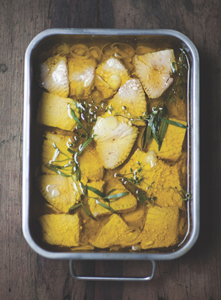
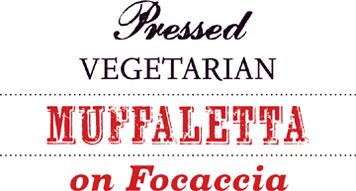

Much like the battle between proponents of the Dungeness crab and those who favor the blue, the muffaletta is one of those things that prompts people to take sides. In this case, it’s a question of hot versus cold. Again, I take the generous view: I appreciate the toasted airy bread, barely melted cheese, warmed olive salad, and Italian meats (just releasing their fat) served on a light brown melamine plate at the Napoleon House. I am equally admiring of the thick, butcher paper–swaddled disk handed over by one of the stoics behind the counter at Central Grocery that, when opened, reveals a soft dense bread, pungent olive salad, and layers of cold meats and cheeses. They are both New Orleans classics. Here I take out the meat and opt for hot. A meatless muffaletta may seem an odd choice. But when we opened Town Hall, we wanted a vegetarian sandwich, and since the olive salad sets the muffaletta apart (as does the bread, though focaccia is a worthy stand-in), I think you’ll be pleased with the results. And if you’re feeling carnivorous, go ahead. You know what to do.

 MAKES 6 SANDWICHES
MAKES 6 SANDWICHES 
OLIVE SALAD
2 cups pitted green Spanish olives, coarsely chopped
1 cup pitted green Greek olives, preferably garlic stuffed, or kalamata olives, coarsely chopped
7 peperoncini, coarsely chopped
2 cloves garlic, finely chopped
2 tablespoons capers, rinsed and lightly chopped
1¼ cups Pickled Vegetables with Coriander and Celery Salt or jarred pickled Italian vegetables (giardiniera), roughly chopped, plus 1 tablespoon of the pickling liquid
1 teaspoon dried oregano
¼ cup red wine vinegar
1¼ cups olive oil
½ lemon
1 teaspoon salt
2 large red bell peppers
6 pieces focaccia, each 4 inches square, split horizontally, or 3 muffaletta loaves, each halved crosswise and then split horizontally
12 slices provolone cheese
Unsalted butter, at room temperature, or olive oil
TO MAKE THE OLIVE SALAD, in a large bowl, combine all of the ingredients and mix well. Let stand for at least 1 to 2 hours, or preferably overnight.
Using tongs, one at a time, hold the bell peppers over the flame of a gas burner, turning as needed, until blackened and blistered on all sides. Or, blacken and blister the peppers under a preheated broiler, watching carefully to avoid burning the flesh. Transfer the blackened peppers to a bowl, cover with plastic wrap, and let stand for 10 minutes. Remove from the bowl and let cool to room temperature. Peel the peppers, cut in half, and discard the seeds, then cut lengthwise ½-inch-wide slices. Set aside.
Preheat the oven to 400°F. Arrange the bottom halves of the split focaccia squares on a work surface. Spoon a few heaping tablespoons of the olive salad on each square and spread evenly. Top the olive salad with 2 cheese slices and a few slices of roasted pepper, and then with the tops of the squares.
Smear the top and bottom of each sandwich with the butter (or brush with the olive oil). Heat a large nonstick frying pan over medium heat. Add as many sandwiches as will fit comfortably and heat for 3 to 4 minutes, or until browned on the first side. Carefully flip the sandwiches over and place a sandwich press (or a brick covered with aluminum foil) on top of the sandwiches. Cook for 1 minute, then transfer to a sheet pan. Repeat with the remaining sandwiches.
When all of the sandwiches have been browned, put the sheet pan in the oven for about 6 minutes, or until the sandwiches hot throughout. Serve at once.
Lobster Roll with Old Bay and Celery


This lobster roll, lightly dressed on a buttery center-sliced bun, is directly tied to the founding of Anchor & Hope. A few years back, on a family vacation in Maine, we were waiting for some friends at a ferry landing for a trip to Little Cranberry Island. They arrived a touch late, carrying a large box that they offered in apology for the delay. The box was filled with lobster rolls from the local “pound.” We tore into its contents right after we boarded. This was my introduction to Maine. The first bite told me that I liked Maine, and I was immediately committed to trying every lobster roll I could get my hands on (I’m all hands). Some were dressed with just clarified butter, and others used mayonnaise. Either way, I was taken by the flavor and the play of the cool lobster against the warm, toasty roll.
Fast-forward a few months and I’m walking past a small building being used as parking lot on Minna Street, right around the corner from Salt House. The wide garage door was open, and when I peeked inside, its wood floors and airy, weathered appearance reminded me of the structures on the coast of Maine. Doug was keen on a fish house. This was it.
I’ll emphasize it again: lightly dressed. You want to enhance the flavor of the lobster, not overwhelm it. As Wolfgang Puck once said, while instructing a young cook who oversauced a plate of lobster, “Why would you cover gold?”

 MAKES 6 SANDWICHES
MAKES 6 SANDWICHES 
1½ pounds fresh-cooked lobster meat, chopped and chilled (see How to Cook and Clean a Lobster)
1 celery stalk, finely diced
1 tablespoon freshly squeezed lemon juice
2 teaspoons finely chopped fresh tarragon
½ teaspoon Old Bay Seasoning
1 or 2 pinches of salt
½ cup Mayonnaise, chilled
Unsalted butter, at room temperature, for spreading
6 top-loading hot dog buns (see note)
6 lemon slices
PLACE a dry cast-iron frying pan in the oven and preheat the oven (as well as the pan) to 375°F.
Meanwhile, in a bowl, combine the lobster, celery, lemon juice, tarragon, Old Bay, salt, and mayonnaise and stir and toss gently to distribute all of the ingredients evenly. Make sure all of the lobster chunks are lightly coated with mayonnaise. Set aside.
Spread a liberal amount of the butter on the exposed outer sides of each bun. Then, working in batches to avoid crowding, put the buns in the hot frying pan and cook, turning once, for about 3 minutes on each side, or until golden brown.
Spoon the lobster mixture into the hot buns, dividing it evenly. Serve the lobster rolls immediately with a slice of lemon.
NOTE: Ideally, you want to use a top-loading hot dog bun. That’s because the outer crust is removed from the sides of the bun, exposing the soft inside, making it perfect to slather with butter and cook to a crispy golden brown. If you cannot find the buns, look for an uncut roll of similar size. With a bread knife, cut a thin portion off each side of the roll, then slice down the center of the top, stopping just short of cutting all of the way through.
Fish Tacos with Avocado Crème and Spicy Chipotle Salsa


This chapter is emphatically titled Sandwiches, Sandwiches, Sandwiches. Is a taco a sandwich? Who am I to say? So let’s dispense with semantics and admit that, whatever the category, the taco is classic hand food. Here, a warmed tortilla is folded over a perfectly grilled chunk of fish and, instead of an avocado slice, a dollop of avocado crème is added, which contributes a welcome lightness and contrasts nicely with the spicy salsa. Because of their size, it is best to grill the fish pieces in a basket or on a screen, which makes them easier to turn. If you’re not comfortable grilling, you can always cook the fish in a pan on the stove top (see note). And if you’re not comfortable calling a taco a sandwich, just take a pen and add “and a Taco” to the title of this chapter.

 MAKES 12 TACOS; SERVES 6
MAKES 12 TACOS; SERVES 6 
CHIPOTLE SALSA
6 dried chipotle chiles
½ pound tomatillos, papery skins removed
½ pound tomatoes
2 jalapeño chiles, split lengthwise and seeded
8 cloves garlic, peeled and roughly chopped
½ yellow onion, sliced
1½ teaspoons salt
¼ cup canola oil
¼ cup water
2 teaspoons cider vinegar
AVOCADO CRÈME
1 avocado, halved, pitted, and peeled
¾ cup crème fraîche
Juice of 1 lime
1 tablespoon chopped fresh cilantro
1 teaspoon salt
1½ pounds firm-fleshed white fish fillets such as grouper, tilapia, or bass
⅓ cup extra-virgin olive oil
Juice of 1 lime
¼ teaspoon pure chili powder
Pinch of salt
12 corn tortillas, about 6 inches in diameter
½ head green cabbage, cored and thinly sliced
TO PREPARE THE SALSA, bring a small pot of water to a boil. Meanwhile, in a dry frying pan, lightly toast the chipotle chiles over medium heat for a few minutes, or until fragrant. Transfer the chiles to a heatproof bowl, pour the boiling water over the top to cover, and set aside.
Place the tomatillos, tomatoes, jalapeño chiles, garlic cloves, and onion slices in a large, ridged stove-top grill pan or cast-iron frying pan over medium heat. Roast the vegetables, turning often, for 10 to 15 minutes, until they are nicely charred. Remove from the heat and then let cool for 5 to 10 minutes.
While the vegetables are cooling, remove the chipotles from the water. Chop off the stems and scrape out the seeds.
Remove the skin from the tomatoes only, and then place the tomatoes in a food processor or blender. Add the remaining roasted vegetables, the seeded chipotles, the salt, oil, water, and vinegar and process until smooth. Transfer to a bowl and set aside.
TO PREPARE THE AVOCADO CRÈME, place the avocado in a bowl and mash it into small chunks with a fork. Transfer the avocado to the food processor, add the crème fraîche, lime juice, cilantro, and salt, and process until smooth. Transfer to a bowl and set aside.
Prepare a medium-hot fire for direct-heat grilling in a charcoal or gas grill. While the grill is heating, cut the fish into 12 equal portions (about 2 ounces each). In a bowl, whisk together the oil, lime juice, chili powder, and salt. Add the fish and toss well.
Grill the fish, turning once, for 3 to 4 minutes on each side (depending on the thickness), or until just opaque at the center. At the same time, place the tortillas around the edge of the grill rack and heat for 30 to 45 seconds on each side.
TO ASSEMBLE THE TACOS, place a piece of fish in the center each tortilla, add a spoonful of salsa, some sliced cabbage, and a dollop of the avocado crème fraîche. Serve 2 tacos to each diner.
NOTE: I prefer grilling, but you can also cook the fish in a frying pan. In a large frying pan, heat a tablespoon or two of olive oil over medium-high heat. Working in batches to avoid crowding, add the fish and cook, turning once, for 1½ to 2 minutes on each side (depending on thickness), or until just opaque at the center. Heat the tortillas in cast-iron frying pan over medium heat at the same time.
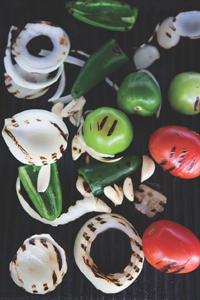


This sandwich has been with me for a long time, and with good reason. It originated at Postrio, moved on to Anchor & Hope, and now is a popular staple on the lunch and brunch menu at the Irving Street Kitchen in Portland. Make sure you use thick-cut apple-smoked bacon, and take care to pat the shrimp very dry before cooking. The less moisture there is, the better the smoke adheres to the shrimp, and the more smoke adheres to the shrimp, the more that is picked up by the sauce. You get the idea. Like any good sandwich, this one is messy, but what a mess. And if you’re feeling extravagant, go ahead and smoke some lobster.

 MAKES 6 SANDWICHES
MAKES 6 SANDWICHES 
12 slices thick-cut apple-smoked bacon
36 large shrimp (about 1½ pounds), peeled and deveined
12 slices coarse country bread such as pain levain, cut as thinly as possible on the diagonal
Olive oil, for brushing
Salt
½ cup water
2 tablespoons freshly squeezed lemon juice
½ cup (¼ pound) unsalted butter, chilled, cut into 8 tablespoons
Salt
¾ cup Mayonnaise
2 large tomatoes, each cut into 6 thin slices
4 cups mixed salad greens
PREPARE an offset smoker or a grill for smoking (see Smoking Techniques). You want it to be at about 225°F.
Meanwhile, preheat the oven to 375°F. Lay the bacon on a sheet pan and bake for 10 to 15 minutes, or until crisp. Transfer to paper towels to drain. Turn the oven to broil.
Pat the shrimp dry with a kitchen towel to rid them of as much moisture as possible (the smoke flavor will adhere better to dry skin). Arrange the shrimp on the grill rack and smoke over very low for about 8 minutes, or until medium-rare (half cooked).
While the shrimp are cooking, toast the bread and make the sauce. Arrange the bread slices on a sheet pan. Brush the top side of each slice with oil and then season with a pinch of salt. Place under the broiler for a few minutes, or until nicely toasted. Set aside.
TO MAKE THE SAUCE, in a sauté pan, combine the water and lemon juice over medium-high heat and simmer until reduced by half. Turn down the heat to low and add the cold butter, 1 tablespoon at a time, whisking constantly after each addition until incorporated. Season with a few pinches of salt.
When the shrimp are ready, add them to the sauce for 1 minute or so, to finish cooking and warm through.
TO ASSEMBLE THE SANDWICHES, spread 1 tablespoon of the mayonnaise on the oiled side of each bread slice. Place 6 shrimp, side by side, on 6 of the bread slices, then top the shrimp with 2 tomato slices followed by 2 bacon slices. Arrange a handful of greens on top, then a second slice of bread, mayonnaise side down. Cut each sandwich in half on the diagonal and serve.


Food in New Orleans causes lots of arguments. Like when you are on line at the neighborhood po’boy shop and arguing whether to go with the fried oyster loaf or the fried shrimp. This argument is internal, and results in a series of interior negotiations and deliberations until compromise is reached: half oyster, half shrimp. One sandwich, both cravings assuaged. That’s why this is called The Peacemaker: it helps you make peace with yourself.
Use medium-sized oysters and large shrimp for the best result. The key here is to make sure the crispy coating on the shrimp and oysters is neither coarse nor mealy. Corn flour does the trick beautifully. Finally, I like to use Crystal hot sauce, but as this sandwich is called The Peacemaker, I’d rather not argue. Use any hot sauce you’d like.

 MAKES 6 SANDWICHES
MAKES 6 SANDWICHES 
1 cup Mayonnaise
2 tablespoons Crystal hot sauce
Canola oil, for deep-frying
2 cups corn flour
2 cups all-purpose flour
2 teaspoons cayenne pepper
2 teaspoons salt
Freshly ground black pepper
2 cups buttermilk
1 pound large shrimp, peeled and deveined
1 pound freshly shucked medium-sized oysters (sold in a jar or tub)
1 head romaine lettuce, thinly sliced crosswise
2 tomatoes, thinly sliced
2 loaves French bread, each cut crosswise into thirds (about 6 inches long), then each third split horizontally
IN A SMALL BOWL, stir together the mayonnaise and hot sauce, mixing well. Set aside.
Pour the oil to a depth of about 3 inches into a deep fryer or deep cast-iron frying pan and heat to 375°F. While the oil is heating, line a sheet pan with waxed paper. In a large bowl, stir together both flours, the cayenne pepper, the salt, and a few grinds of pepper. Pour the buttermilk into a second bowl, add the shrimp, toss to coat, and let soak for a minute or two. Then, working in batches, scoop the shrimp out of the buttermilk, allowing the excess liquid to drip back into the bowl, and add to the flour mixture. Toss to coat evenly, then shake off the excess and place on the prepared sheet pan. When all of the shrimp are coated, repeat the process with the oysters. (It is important that you soak the shrimp in the buttermilk first, as the oysters tend to, for lack of a better term, and because this is a New Orleans specialty, make the buttermilk funky).
Again working in batches to avoid crowding, add the shrimp to the hot oil and fry for about 1½ minutes, or until golden brown. Using a wire skimmer or slotted spoon, transfer to paper towels to drain. Keep warm. Repeat with the oysters, frying each batch for about 2 minutes, or until golden brown, then drain on paper towels.
Smear a liberal amount of the mayonnaise–hot sauce mixture on the bottom of each bread piece, then place 3 or 4 each of the hot fried shrimp and oysters on top. (If you want a little more spice, hit the shrimp and oysters with a few dashes of hot sauce, straight from the bottle.) Top with the lettuce and tomato slices and then the bread tops and serve.
Curried Chicken Sandwich with Cashews and Currants


This sandwich is a mystery to me. For one thing, I don’t remember how or why it came on the menu. I mean, it really is outside of what we usually do at Town Hall, but whenever we run this Curried Chicken sandwich for the noon-time crowd, it is super-popular. One theory I have for this sandwich making its way to the Bill of Fare is that while curry is an important element here, by Town Hall standards, this sandwich is pretty mild. It harkens to a British tea sandwich, but bigger, you know, for Americans. It would be easy to make the flavors more aggressive, but this sandwich is subtle, making for an easy lunch. Feel free, though, to take out any aggression you might have and spice this one up with a fruit chutney or some pickled mango.

 MAKES 6 SANDWICHES
MAKES 6 SANDWICHES 
½ yellow onion, sliced
1 teaspoon dried chile flakes
3 cardamom pods
½ cinnamon stick
1 bay leaf
Salt
2 quarts water
2 pounds boneless chicken breasts
⅓ cup dried currants
½ cup roasted cashews, roughly chopped
½ cup diced apple
⅓ cup diced fennel
⅓ cup diced celery
½ cup Mayonnaise
1½ tablespoons curry powder
2 tablespoons freshly squeezed lemon juice
Salt and freshly ground pepper
4 cups mixed salad greens
8 fresh basil leaves, torn
8 fresh mint leaves, torn
6 soft rolls, split horizontally
TO POACH THE CHICKEN, in a wide saucepan, combine the onion, chile flakes, cardamom, cinnamon, bay leaf, 1 teaspoon salt, and water, bring to a boil, and boil for about 10 minutes. Lower the heat so the water is barely simmering, add the chicken breasts, and cook gently for 15 to 20 minutes, or until the chicken is opaque throughout.
Remove the chicken breasts from the poaching liquid and discard the liquid. Pat the chicken breasts dry, season with a little salt, and let cool completely.
Meanwhile, in a small bowl, soak the currants in lukewarm water to cover for 10 minutes to plump them. Drain well and set aside.
When the chicken is cool, shred it into a large bowl. Add the currants, cashews, apple, fennel, celery, mayonnaise, curry powder, and lemon juice and mix well to combine. Season with salt and pepper.
TO ASSEMBLE THE SANDWICHES, in a bowl, toss together the salad greens, basil, and mint. Lay the bottom halves of the rolls, cut side up, on a work surface. Divide the chicken salad equally among them, then top the salad with a handful of greens. Close with the roll tops, cut in half, and serve.


Think about a picnic: a checkered tablecloth, a basket filled with fried chicken and coleslaw, a bottle of wine. Now think about it between two slices of bread. Not the basket and the tablecloth but the chicken and the slaw (wine is always best in a glass). That’s what this sandwich is like.
Although the chicken is soaked in buttermilk and dredged in flour like the fried chicken in Chapter 7, these boneless breasts are cooked at a higher temperature, resulting in an incredibly moist, beautifully colored piece of meat. Make sure you drain the spicy slaw well so you don’t drench the wonderful crisp exterior of the chicken.
At Town Hall’s lunch service, we sell 150 of these pocket picnics daily, so they are, by necessity, served at room temperature.

 MAKES 6 SANDWICHES
MAKES 6 SANDWICHES 
BUTTERMILK-JICAMA SLAW
½ head green cabbage, cored and thinly sliced crosswise
½ small jicama, peeled and julienned
2 shallots, thinly sliced
¼ cup fresh cilantro leaves, chopped
2 jalapeño chiles, seeded and thinly sliced
Grated zest of 1 lime
1 cup buttermilk
½ cup crème fraîche
1 tablespoon cider vinegar
Juice of 1 lime
1 teaspoon salt
Freshly ground pepper
FRIED CHICKEN
6 boneless, skinless chicken breasts
Salt and freshly ground pepper
1 cup buttermilk
Canola oil, for deep-frying
2 cups all-purpose flour
¼ cup Town Hall Spice Mixture
½ cup Mayonnaise
6 ciabatta rolls, split horizontally
TO MAKE THE SLAW, combine the cabbage, jicama, shallots, cilantro, chiles, and lime zest and toss to mix. In a small bowl, whisk together the buttermilk, crème fraîche, vinegar, lime juice, salt, and a few grinds of pepper. Pour the dressing over the vegetables and toss to coat evenly. Let stand for at least 30 minutes before serving or refrigerate for up to 2 days.
One at a time, place the chicken breasts between 2 sheets of plastic wrap. Using a meat mallet or a rolling pin, pound gently until flattened to a uniform ½ inch thick. Season on both sides with salt and pepper.
Pour the buttermilk into a bowl. Add the chicken breasts, turn to coat, and let soak for about 15 minutes.
TO FRY THE CHICKEN, pour the oil to a depth of 3½ inches into a deep fryer or a deep, heavy-bottomed pot and heat to 375°F. In a bowl, stir together the flour, spice mixture, and 1 teaspoon salt. Line a sheet pan with waxed paper. One at a time, remove the chicken breasts from the buttermilk, allowing the excess liquid to drip back into the bowl, and add to the flour mixture. Toss to coat evenly, then shake off the excess and place on the prepared sheet pan.
Add the chicken breasts to the hot oil and cook for 4 to 5 minutes, or until golden brown. Transfer to paper towels to drain.
TO ASSEMBLE THE SANDWICHES, spread a generous tablespoon of mayonnaise on the bottom of each roll. Lay a fried chicken breast on the bottom half and top with a few heaping spoonfuls of the slaw. Place the other half of the roll on top, slice in half, and serve hot or cold.


Here is another way to use the fried chicken breast, this time for an open-faced, knife-and-a-fork sandwich. The country-style gravy, generously flecked with bits of sausage and bacon, uses a shot of strong coffee for a variation on red-eye gravy, a southern favorite.

 6 SANDWICHES
6 SANDWICHES 
1 teaspoon canola oil
3 slices thick-cut bacon, cubed
3 ounces breakfast pork sausage links, casings removed
½ yellow onion, sliced
2 tablespoons unsalted butter
¼ cup all-purpose flour
3 tablespoons brewed espresso or other strong coffee
3 cups Chicken Stock, warmed
Salt and freshly ground pepper to taste
½ cup heavy cream
1 teaspoon chopped fresh sage
6 fried chicken breasts,
IN A FRYING PAN, heat the oil over medium heat. Add the bacon and cook, stirring occasionally, for about 3 minutes, or until some of the fat is rendered. Add the pork sausage meat and cook, breaking up the meat with a wooden spoon or spatula, for 3 minutes more, or until it just starts to brown. Add the onion. Continue cooking, stirring occasionally, for about 5 minutes, or until the onion is soft.
Add the butter and stir until melted. Lower the heat to medium-low. Stir in the flour and cook, stirring constantly, for 2 to 3 minutes to cook away the raw flour taste. Pour in the espresso and stock and stir well, making sure to scrape the bottom of the pan to dislodge any browned bits. Raise the heat to medium and simmer for about 10 minutes, or until reduced by half.
Add the cream and cook, stirring occasionally, for about 10 minutes, or until the mixture has a nice gravy consistency. Finally, stir in the sage, then taste and correct the seasoning.
Split each biscuit in half horizontally and lay the halves, cut side up and side by side, on a plate. Top with a hot fried chicken breast, ladle the hot sauce on top, and serve immediately.
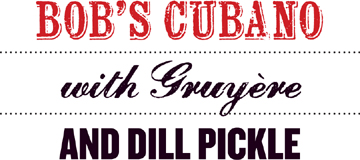

The roots of this sandwich are as controversial as any, but while Miami and Key West attempt to lay claim to the original, my research finds that the famous Cubano was introduced by cigar workers in Tampa’s Ybor City neighborhood, who used a tailor’s iron to press and heat sandwiches of ham, pork, and pickle. I am not entirely sure it is true (though I do like the detail of the tailor’s iron), but whoever invented the Cubano, well, good for him or her and for the rest of us. At Salt House, we use roasted pork tenderloin dusted with cumin and coriander, serrano ham (you can use prosciutto or speck) and Gruyere cheese. If you have a sandwich press, great. If not, you can press it in the pan. And if you’re a tailor …

 MAKES 6 SANDWICHES
MAKES 6 SANDWICHES 
ROASTED PORK
2 cups freshly squeezed orange juice
1 jalapeño chile, sliced
1 small bunch cilantro, chopped
2 pounds pork tenderloin
1 teaspoon coriander seeds
1 teaspoon cumin seeds
Salt and freshly ground pepper
2 tablespoons olive oil
6 torpedo rolls, split horizontally
Dijon mustard
12 slices serrano ham, prosciutto, or speck
12 slices Gruyère cheese
1 large dill pickle, sliced
4 pickled jalapeño chiles, sliced
Unsalted butter, at room temperature
TO MAKE THE MARINADE for the roasted pork, in a small bowl, stir together the orange juice, chile, and cilantro. Place the pork in a baking dish, pour the marinade over the top, and turn the pork to coat evenly. Cover and refrigerate overnight, turning once.
When ready to cook, preheat the oven to 400°F. Place a rack in a roasting pan just large enough to accommodate the pork.
Meanwhile, in a small, dry frying pan, toast the coriander and cumin over medium heat, shaking the pan often to avoid scorching, for about a minute, or until fragrant and just turning color. Let cool completely, then grind finely in a spice grinder or in a mortar with a pestle.
Remove the pork from the marinade and pat dry. Season liberally with salt, pepper, and the ground cumin and coriander. In a large sauté pan, heat the oil over high heat. When the oil shimmers, add the pork and sear, turning as needed, for about 1½ minutes on each side, or until lightly browned. Transfer the pork to the rack in the roasting pan and roast for 30 to 40 minutes, or until an instant-read thermometer inserted into the thickest part of the pork registers 150°F. Remove from the oven and let cool completely.
TO ASSEMBLE THE SANDWICHES, slice the cooled pork against the grain as thinly as possible. Season the slices lightly with salt. Place the rolls, cut sides up, on a work surface, and spread the cut sides with the mayonnaise and then the mustard. Divide the pork slices evenly among the rolls, placing them on the bottom half. Top with 2 ham slices and 2 cheese slices, then divide the dill pickle and pickled chile slices evenly among the sandwiches. Close the sandwiches with the roll tops.
Smear the top and bottom of each sandwich with the butter. Heat a large frying pan over medium heat. Add as many sandwiches as will fit comfortably and heat for 3 to 4 minutes, or until browned on the first side. Carefully flip the sandwiches over and place a sandwich press (or a brick covered with aluminum foil) on top of the sandwiches. Cook for 1 minute, then transfer to a sheet pan.
When all of the sandwiches have been browned, put the sheet pan in the oven for about 6 minutes, or until the sandwiches are hot throughout. Serve at once.
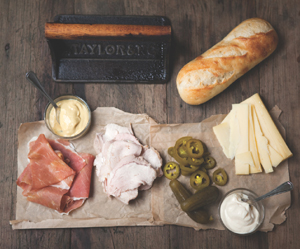


Here is a proper sausage recipe from our butcher, Luis. I know that with the grinding, the casing, and the poaching it all sounds a bit daunting, but if you follow the instructions faithfully and see the process through to the end, you’ll be rewarded. Combining freshly made sausages with sweet and spicy Peppadew peppers and simply dressed arugula makes this sandwich something truly special. If you’re pressed for time, you can form the mixture into patties (see note). The flavor will still be great, though you will lose a little something in texture because you’ll lose some of the fat. You can’t get around it: fat is an important element in sausage making. Pork is a wonderful provider. After serving a platter of your own homemade sausage sandwiches, you’ll be one, too.

 MAKES 6 SANDWICHES
MAKES 6 SANDWICHES 
ITALIAN SAUSAGES
2½ pounds boneless pork butt, cut into chunks
1 tablespoon toasted fennel
1 tablespoon kosher salt
1¼ teaspoon freshly ground pepper
1 teaspoon dried chile flakes
½ cup Chicken Stock or water, chilled
7 to 8 feet natural hog or sheep casings, well rinsed
2 cups arugula
Extra-virgin olive oil
Sea salt
Torpedo rolls, split horizontally and cut sides toasted
12 to 14 pickled Peppadew peppers, seeded and chopped
TO MAKE THE SAUSAGES, place the meat in a bowl and put the bowl in the freezer, along with the food grinder attachment of your stand mixer and the medium disk, for 15 minutes.
Meanwhile, in a small, dry frying pan, toast the fennel seeds over medium-high heat, shaking the pan often to avoid scorching, for about a minute or two, or until they just turn golden brown and are fragrant. Pour onto a cutting board and chop coarsely.
Fit the grinder attachment to the stand mixer and pass the pork through the grinder into the mixer bowl. Add the fennel, kosher salt, pepper, chile flakes, and stock to the ground pork. Fit the mixer with the paddle attachment and mix on low speed for 1 minute. Increase the speed one setting and mix for 1 minute longer, or until well combined.
Now fit the mixer with the sausage stuffer attachment. Transfer the sausage mixture to the stuffer, slip a casing onto the stuffer tube, and fill the casing. Repeat until you have used up all of the sausage mixture, then twist the stuffed casings into sausages 5 to 7 inches long. You should have 6 sausages.
Fill a large pot with water, place over low to medium-low heat, and heat until the water registers 160°F on an instant-read thermometer. Add the sausages to the water and poach, stirring occasionally, for about 15 minutes, or until the internal temperature of a sausage registers 140°F on the thermometer. Remove the sausages from the water.
You can now grill the sausages on a stove-top ridged grill pan over medium heat or over a medium-hot fire in a charcoal or gas grill until browned and warmed through, or you can panfry them over, you guessed it, medium heat until browned and warmed through.
TO ASSEMBLE THE SANDWICHES, in a bowl, toss the arugula with a little olive oil and sea salt. Spread the cut sides of the rolls with the mayonnaise, then place a hot sausage on each roll. Add some peppers and arugula to each sandwich, then close the sandwiches and serve immediately.
NOTE: If you don’t have equipment to grind the meat at home, ask your butcher to grind it for you. If you don’t have a sausage stuffer, shape the sausage mixture into patties to fit the rolls and about ¼ inch thick, then fry in a frying pan in a little olive oil until nicely browned and cooked through.
Smoked Andouille Sausage
